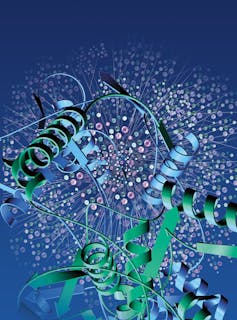Striking evidence has emerged that an ancient virus previously known only from fossil evidence has persistently infected some humans at very low levels for hundreds of thousands or even millions of years. This ancient retrovirus is a kind of living fossil, and the discovery of an intact copy of it within the human genome poses questions as to how it has survived, and suggests others from the distant evolutionary past may lie dormant in the DNA of many species.
A retrovirus replicates by inserting its genome into that of an infected cell. Occasionally, retroviruses infect germ line cells – those found in eggs and sperm – and if these cells survive and go on to create a new organism, that new organism will contain the retrovirus as an inherent part of its genome. In this way the genomes of many mammals, birds and other vertebrates have accumulated many DNA sequences derived from retroviruses, known as endogenous retroviruses (ERVs). About 8% of the human genome is comprised of ERVs, for example.
The vast majority of these sequences are genomic fossils in an advanced state of decay, and incapable of producing any sort of infectious particles. Intriguingly, however, some ERVs have been co-opted to perform physiological functions within the host organism, for example to provide immunity. These domesticated virus sequences, though functional, have effectively become part of the host’s genome. They cannot produce infectious virus particles either, having generally lost the genetic equipment required to do so.
Nevertheless, there are a small proportion of ERV sequences that can make infectious particles, and these show that the genomes of host species can be colonised by infectious retroviruses. This process is poorly understood, but recent research has shown the almost unbelievable stealth with which it can occur, so that the most modern and powerful techniques are required to detect it.
The ‘Loch Ness Monster’ of the human genome

Advances in whole genome sequencing have revealed a huge diversity of ERVs in the genomes of vertebrates with considerable difference between species. Many are extremely ancient, while more recent ERVs are more intact and less degraded by mutation. In some species such as mice, the genome contains many ERVs capable of producing infectious viruses, but almost all ERVs in humans (known as HERVs) appear to be non-functional remnants of extinct retroviruses. The only exception is one group, called HERV-K, which is potentially capable of replication despite being many millions of years old.
Previous studies of HERV-K sequences in the human genome have indicated that it has been recently active in humans, and that it could even still circulate through infection. This recent study’s co-authors, Julia Wildschutte and Zach Williams, working in the laboratory of John Coffin at Tufts University, searched for evidence of HERV-K using data from the 1000 Genomes Project and the Human Genome Diversity Project. The team developed approaches that allowed them to dig exceptionally deep into these catalogues and establish that the human genome contains a total of 36 unique HERV-K copies not present in the standard, reference human genome sequence – including 19 new discoveries.
Most intriguingly of all, one of these new discoveries was an intact virus without any of the mutations that would be expected to degrade its function. The discovery of an intact virus lurking in the human population strengthens the possibility that this HERV-K retrovirus has remained “alive” within humans up until relatively recently, and could still be circulating somewhere even today.
Future directions
Many questions remain: is HERV-K really still active in humans? Is it lying dormant, poised to re-emerge as the agent of an infectious epidemic? Or are the signs of recent HERV-K activity really just the death throes of an ancient retrovirus as it drifts slowly but surely toward extinction?
It may be that by existing in a near-dormant state with only very low levels of activity, HERV-K has been able to evade the effects of mutations that would have inactivated it. Alternatively, there might be circumstances in which humans in some way gained a survival advantage that led to the presence of HERV-K in human DNA being selected for through evolutionary processes.
These hypotheses can be investigated to some extent because extinct retroviruses can be resurrected from DNA remnants and their biological properties analysed. Studying how ancient viruses were extinguished by their host species can provide clues to strategies we might use to help fight the viruses that threaten us today.

